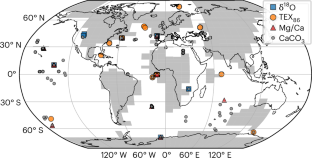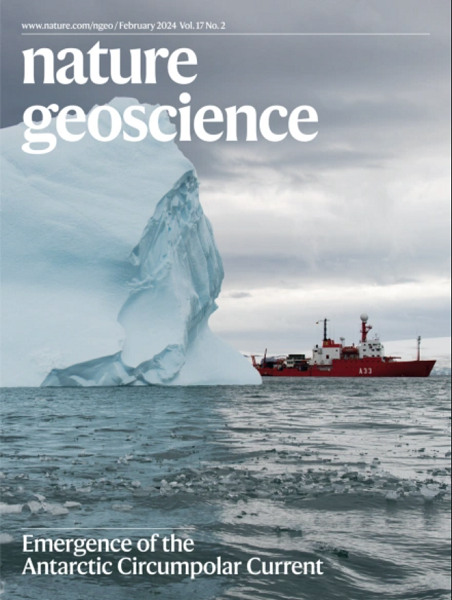Coupled decline in ocean pH and carbonate saturation during the Palaeocene–Eocene Thermal Maximum
IF 15.7
1区 地球科学
Q1 GEOSCIENCES, MULTIDISCIPLINARY
引用次数: 0
Abstract
The Palaeocene–Eocene Thermal Maximum, a climate event 56 million years ago, was characterized by rapid carbon release and extensive ocean acidification. However, our understanding of acidification and the evolution of ocean saturation states continues to be hindered by considerable uncertainties, primarily stemming from the limited availability of proxy data. Under such conditions, data assimilation allows for an internally consistent assessment of atmospheric CO2 changes, ocean acidification and carbonate saturation state during this period. Here, we present a reconstruction of the Palaeocene–Eocene Thermal Maximum carbon cycle perturbation by assimilating seafloor sediment CaCO3 and sea surface temperature proxy data with simulations from an Earth system model, which includes a comprehensive carbonate system. Our reconstructions indicate a substantial increase in atmospheric CO2 from 890 ppm (95% credible interval: 680–1,170 ppm) to 1,980 ppm (1,680–2,280 ppm), coupled with a notable decline in pH (0.46 units, ranging from 0.31 to 0.63 units) and surface-water calcite saturation state, decreasing from 10.2 (7.5–12.8) in the pre-event period to 3.8 (2.8–5.1) during the thermal maximum. Carbonate undersaturation intensified substantially in high-latitude surface waters during the Palaeocene–Eocene Thermal Maximum, paralleling the current decline in Arctic aragonite saturation driven by anthropogenic CO2 emissions. Elevated atmospheric CO2 during the Palaeocene–Eocene Thermal Maximum coincided with substantial declines in the pH and carbonate saturation state of the ocean.


古新世-始新世热极盛期海洋 pH 值和碳酸盐饱和度的耦合下降
距今5600万年前的古新世-始新世热极盛期气候特征是碳的快速释放和海洋的广泛酸化。然而,我们对酸化和海洋饱和状态演变的理解仍然受到相当大的不确定性的阻碍,这主要源于代用数据的有限性。在这种情况下,数据同化可以对这一时期的大气二氧化碳变化、海洋酸化和碳酸盐饱和状态进行内部一致的评估。在这里,我们通过同化海底沉积物 CaCO3 和海面温度代用数据以及地球系统模型模拟结果,重建了古新世-始新世热极值碳循环扰动。我们的重建结果表明,大气中的二氧化碳含量从 890 ppm(95% 可信区间:680-1170 ppm)大幅增加到 1,980 ppm(1,680-2,280 ppm),同时 pH 值(0.46 个单位,从 0.31 个单位到 0.63 个单位不等)和表层水方解石饱和状态明显下降,从事件前时期的 10.2(7.5-12.8)下降到热极盛时期的 3.8(2.8-5.1)。在古新世-始新世热极值期间,高纬度表层水碳酸盐饱和度不足的情况大大加剧,与目前人为二氧化碳排放导致北极文石饱和度下降的情况类似。
本文章由计算机程序翻译,如有差异,请以英文原文为准。
求助全文
约1分钟内获得全文
求助全文
来源期刊

Nature Geoscience
地学-地球科学综合
CiteScore
26.70
自引率
1.60%
发文量
187
审稿时长
3.3 months
期刊介绍:
Nature Geoscience is a monthly interdisciplinary journal that gathers top-tier research spanning Earth Sciences and related fields.
The journal covers all geoscience disciplines, including fieldwork, modeling, and theoretical studies.
Topics include atmospheric science, biogeochemistry, climate science, geobiology, geochemistry, geoinformatics, remote sensing, geology, geomagnetism, paleomagnetism, geomorphology, geophysics, glaciology, hydrology, limnology, mineralogy, oceanography, paleontology, paleoclimatology, paleoceanography, petrology, planetary science, seismology, space physics, tectonics, and volcanology.
Nature Geoscience upholds its commitment to publishing significant, high-quality Earth Sciences research through fair, rapid, and rigorous peer review, overseen by a team of full-time professional editors.
 求助内容:
求助内容: 应助结果提醒方式:
应助结果提醒方式:


